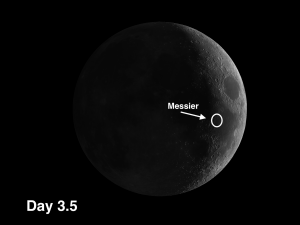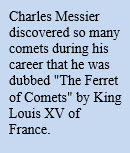The week of January 15-21 takes us from Day 28 (virtually new moon) to Day 4. This week we will highlight the crater Messier, viewable on Saturday evening.

 Messier:1 [SE/K14; L=48°E] One of my favorite objects on the Moon is a small pair of craters named Messier and Messier A. They are located on the western lava plains of the Sea of Fertility and can be easily seen through the smallest telescopes. The craters have a pair of splash rays that resemble the tails of a comet (an appropriate resemblance, considering who they are named after). These rays, which extend about 75 miles to the west, have a happy characteristic in that they are visible under lower angles of illumination. It is unusual to be able to see both a crater and the rays it produced at the same time. (Tycho [SW/P8] is the most conspicuous example of splash rays.)
Messier:1 [SE/K14; L=48°E] One of my favorite objects on the Moon is a small pair of craters named Messier and Messier A. They are located on the western lava plains of the Sea of Fertility and can be easily seen through the smallest telescopes. The craters have a pair of splash rays that resemble the tails of a comet (an appropriate resemblance, considering who they are named after). These rays, which extend about 75 miles to the west, have a happy characteristic in that they are visible under lower angles of illumination. It is unusual to be able to see both a crater and the rays it produced at the same time. (Tycho [SW/P8] is the most conspicuous example of splash rays.)
The most commonly accepted explanation of the origin of this unusual feature is that a projectile came in at a low angle (1° to 5°) from the east, smashed into the Moon to excavate Messier, and then ricocheted. When it landed the second time Messier A was formed, along with its attendant “comet tails.” The projectile’s extremely low angle of approach explains the oblong shape of the craters. Notice that the Messier impact created a butterfly pattern, typical of very low-angle impacts, while the ejecta from Messier A formed the two comet tails.
1 Messier, Charles: (1730-1817) There is virtually no other figure in the pantheon of famous scientists who is more significant to amateur astronomers than Charles Messier. Messier’s most important function, as he saw it, was to hunt down comets. It was his greatest passion, but he was frequently frustrated in his efforts because he kept stumbling across faint fuzzy objects that looked like comets but proved to be nebulas or galaxies. The only way to tell the difference was to come back days later and look at it again. If it had moved, it was a comet.
So that he could avoid repeating the disappointment every time he ran across one of these items, he created a list of 110 “nuisance objects”–things to be avoided when you’re hunting comets. But because these objects happen to be the most interesting things in the sky to look at, today’s amateur astronomers have turned vice into virtue. Observing all 110 of the items on Messier’s list is the number one goal of many fledging astronomers, and there are many who consider that you’re not a “real” astronomer until you have done so.
======================
It is highly recommended that you get a copy of Sky and Telescope’s Field Map of the Moon, the very finest Moon map available for use at the telescope. It is available for $10.95 at www.skyandtelescope.com and on Amazon. All features mentioned in this blog will be keyed to the grid on the Field Map and will look like this: Plato: [NW/D9]
Credits:
Courtesy of Gray Photography of Corpus Christi, Texas
Lunar photos: NASA / USGS / BMDO / LROC / ASU / DLR / LOLA / Moon Globe. Used by permission
- Rupes Cauchy: A Best Known Fault on the Moon - July 22, 2024
- Moon Crater Schickard – Crater Floor has Stripes - July 15, 2024
- Moon Craters Langrenus and Vandelinus - July 8, 2024
